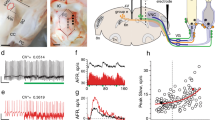Summary
Using the mechanoreceptors in the cat's sinus hair follicles as a model system the recent hypothesis (Hartschuh and Weihe 1980) was tested that Merkel cells are mechanoreceptive sensory cells releasing met-enkephalin as a neurotransmitter to initiate action potentials in the terminals of type I afferent fibres. Since the met-enkephaline antagonist naloxone, even in high doses, did not affect responses in any type I mechanosensitive afferent it is unlikely that a synaptic mechanism with the release of met-enkephalin underlies impulse generation in Merkel cell-axon complexes, nor did naloxone influence the responses from other types of mechanoreceptors.
Similar content being viewed by others
References
Childers SR, Uhl GR, Snyder SH (1978) Opiate receptor and endogenous opioid peptides. Int Rev Biochem 19: 93–127
Gottschaldt K-M, Vahle-Hinz C (1981) Merkel cell receptors: Structure and transducer function. Science 214: 183–186
Gottschaldt K-M, Iggo A, Young DW (1973) Functional characteristics of mechanoreceptors in sinus hair follicles of the cat. J Physiol (Lond) 235: 287–315
Hartschuh W, Weihe E (1980) Fine structural analysis of the synaptic junction of Merkel cell-axon complexes. J Invest Dermatol 75: 159–165
Hartschuh W, Weihe E, Büchler M, Helmstaedter GE, Feurle GE, Forssmann WG (1979) Metenkephaline-like immunoreactivity in Merkel cells. Cell Tissue Res 201: 342–348
Horch KW, Whitehorn D, Burgess PR (1974) Impulse generation in type I cutaneous mechanoreceptors. J Neurophysiol 37: 367–381
Iggo A, Muir AR (1969) The structure and function of a slowly adapting touch corpuscle in hairy skin. J Physiol (Lond) 200: 763–796
Kasprzak H, Tapper DN, Craig PH (1970) Functional development of the tactile pad receptor system. Exp Neurol 26: 439–446
Sawynok J, Pinsky C, LaBella FS (1979) On the specifity of naloxone as an opiate antagonist. Life Sci 25: 1621–1632
Scott SA, Cooper E, Diamond J (1981) Merkel cells as targets of the mechanosensory nerves in salamander skin. Proc R Soc Lond [Biol] 211: 455–470
Sun CL, Gatipon GB (1976) Effects of morphine sulfate on medial bulboreticular response to peripherally applied noxious stimuli. Exp Neurol 52: 1–12
Watkins LR, Mayer DJ (1981) The neural organization of endogenous opiate and non-opiate pain control systems. Science (in press)
Weber U, Hartschuh W, Feurle GE, Weihe E (1980) Metenkephaline-like immuno- and bioreactivity in extracts from skin containing Merkel cells. Neurosci Lett 20: 201–204
Winkelmann RK, Breathnach MS (1973) The Merkel cell. J Invest Dermatol 60: 2–15
Author information
Authors and Affiliations
Additional information
Financially supported by Sonderforschungsbereich 33
Rights and permissions
About this article
Cite this article
Gottschaldt, K.M., Vahle-Hinz, C. Evidence against transmitter function of met-enkephalin and chemosynaptic impulse generation in “Merkel cell” mechanoreceptors. Exp Brain Res 45, 459–463 (1982). https://doi.org/10.1007/BF01208608
Received:
Accepted:
Issue Date:
DOI: https://doi.org/10.1007/BF01208608




